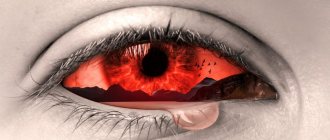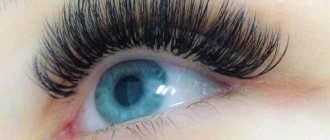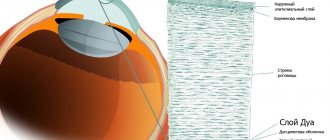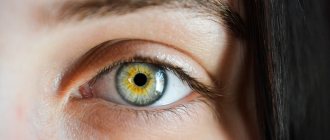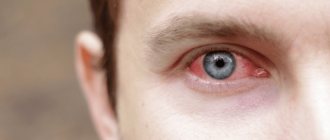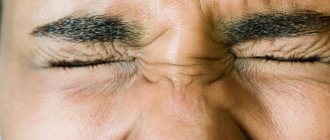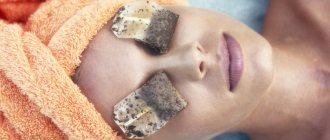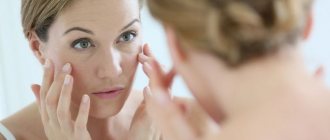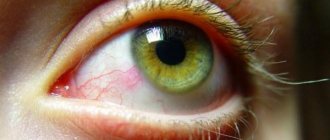Symptoms of Quincke's edema
The development of Quincke's edema is characterized by the appearance of the following symptoms:
- increasing swelling of the face, swelling of the lips and tongue, rapid swelling of the eyelids, itching in these places. It is quite easy to determine serious swelling - the face increases significantly in size, the eyes become numb, and become like slits. The most dangerous thing is if the swelling moves into the oral cavity, first the tongue swells, then the swelling moves to the larynx and trachea, and a sensation of a foreign object appears in the throat. As a result, breathing becomes difficult, leading to bronchospasm. Since swelling leads to a strong narrowing of the lumen of the throat, in severe cases an attack of suffocation occurs.
Quincke's edema on the lips
- swelling of the hands.
- swelling of the joints of the hands and feet. In some cases, Quincke's edema also affects joint tissues - pain appears in the joints of the arms and legs, and there is limited mobility and swelling.
- swelling of the digestive organs.
With swelling of the digestive organs, the main symptoms of edema include pain in the abdomen, difficulty defecating and symptoms of intestinal obstruction. - swelling of the genitourinary system area.
Swelling of the mucous membranes of the urogenital system can lead to difficulty urinating, and even to acute urinary retention. - severe dizziness, pale skin, weakness, nausea and vomiting.
Due to the swelling of the fiber, the surface of the tissues becomes shiny and their structure is dense, the skin color can be either red or pale. From the photo you can easily identify patients with Quincke's edema. But it is not the external, but the internal swelling that spreads to the throat that is especially dangerous. Narrowing of the airways leads to oxygen starvation and suffocation.
If you ignore the symptoms, the consequences for the body can be unpredictable, and it is important to understand what disease has affected the throat. If Quincke's edema is caused by an allergen dangerous to the body, then the pathology develops at lightning speed.
If such symptoms are recorded, it is necessary to urgently call an ambulance; such a condition can result in anaphylactic shock followed by death. Particular attention should be paid to children when such symptoms develop.
Quincke's edema on the face
How to relieve swelling of the nasal mucosa with folk remedies
Nasal swelling can be removed at home or alleviated using available means. Until now, there is almost no scientific evidence that any plant can treat allergies. But this does not prevent the use of this remedy as an auxiliary one. The main condition is that you can practice self-help only if the symptoms of the disease are mild.
- Butterbur grass (Petasites hybridus). Extracts from the herb are used for allergies and asthma. The decoction can be used to wash the mucous membranes.
- Quercetin is an antioxidant and flavonoid. Contained in apples, berries, onions, black tea.
- Carotenoids are a family of plant pigments, the most popular of which is beta-carotene. In any case, the latter will not be harmful for the treatment of rhinitis.
- Omega-3 fatty acids. They do not have a direct effect on allergies, but strengthen the body’s strength.
- Nettle is a herbal remedy. A number of studies suggest that nettle may help with allergy symptoms such as sneezing, nasal congestion and itching by reducing inflammation. Therefore, children with allergic swelling can have their noses washed with nettle decoction.
With all this, allergies are a complex disease and not yet fully understood. Sometimes the sinuses can swell at the slightest hint of an allergen, while in another situation a person feels fine, although there is a flowering field nearby.
Prevention of allergic diseases
Perhaps the best way to avoid allergic swelling is to avoid exposure to offending substances. However, in life this may not always work out. Instead of treating allergic swelling, take the following measures:
- Opt for eco-friendly, easy-to-clean floor coverings. This could be wood or ceramic tiles. Remove carpets.
- Also, instead of fabric curtains, try to use blinds that are easy to wipe clean.
- Wash, clean and vacuum pillows and blankets regularly.
- Use synthetic pillows and acrylic blankets instead of wool blankets, and be sure to avoid feathers.
- Try to use vacuum cleaners equipped with water filters or high-efficiency air filters because they absorb more dust.
- Wipe surfaces with a damp, clean cloth.
We must remember that dust is inhabited by dust mites, whose waste products are allergens. Therefore, you need to especially monitor the cleanliness in all places of your home. Allergic edema is especially common in children, so we pay special attention to their rooms.
Second on the list are pets. The reaction may not be caused by the fur itself, but by exposure to flakes of dead skin, saliva, dried particles of urine, and feces. Of course, this problem cannot be solved radically by removing the pet from the house. Therefore, follow our recommendations:
- Try to keep pets out of the house for as long as possible or limit their movement to one room.
- Keep them out of the bedroom.
- Wash your pets at least once every one to two weeks.
- Bedding, toys, tray - everything should be cleaned and washed.
And of course, you should remember how to relieve swelling in the nose . You should always have antihistamines on hand just in case. And the last of the three largest groups of allergens is pollen. Typically, people are affected during the spring and summer months . Swelling of the nasal mucosa will ruin any walk. To avoid pollen exposure, you may find the following tips helpful:
- Stay indoors during peak flowering times.
- Avoid drying freshly washed clothes outside.
- If the swelling of the nasal sinuses is insignificant, then it is recommended to be outside in the morning, preferably after rain.
- Keep doors and windows closed in the evening, when there is the most pollen in the air.
- Take a shower, wash your hair and change clothes after being outside.
- Avoid parks and squares.
- Clean up the grass around your home and mow your lawn.
Anything can be an allergen. To find out the reason, you have to go to the doctors. Diagnosis is especially difficult in children or if the nasal mucosa swells without a runny nose. In any case, consultation with a competent specialist will not be superfluous.
Causes of Quincke's edema
The most common causes of angioedema include several groups of allergens.
Medications
The most allergenic medications for people are:
- Antibiotics (Amoxiclav, etc.);
- Hormonal drugs – Progesterone, Oxytocin, Insulin, etc.;
- Contrast agents used during diagnostic procedures. Quincke's edema can develop under the influence of iodine-containing substances, mixtures with barium;
- Serums – anti-diphtheria, anti-tetanus, anti-rabies serums;
- Vaccines – anti-tuberculosis, anti-hepatitis, anti-influenza;
- Enzymes – Streptokinase, Chymotrypsin, Pepsin;
- Non-steroidal anti-inflammatory drugs - Analgin, Ibuprofen, Aspirin;
- Vitamins: vitamin E, C, D, as well as folic acid;
- Alcohol, iodine, lactose.
Some medications can cause severe allergies in a matter of seconds. For example, lidocaine can provoke angioedema and anaphylactic shock, which, if first aid is not provided in a timely manner, can lead to death.
Why is this happening? The answer is simple - the allergen drug is administered intravenously or intramuscularly, thus entering the blood directly. Other irritants (food, dust, pollen) overcome a number of barriers before penetrating into the blood, as a result of which their concentration and effect are reduced.
POPULAR WITH READERS: Allergies on the eyelids, what to do, treatment
To find out whether there is an allergy to a particular drug, you must first administer it in a minimal dose. If the skin turns red at the injection site, itching and swelling appear, then it is worth changing the medicine, since in large doses the consequences can be life-threatening. Allergies to medications are described in more detail in our article at the link.
Food
Food products that can cause allergic edema of the Quincke type:
- Fruits - citrus fruits, bananas, watermelon, grapes, kiwi, as well as juices from these fruits;
- Dairy products and whole milk, beef, eggs, butter. These products contain a protein that the human immune system perceives as foreign;
- Fish and seafood. Quincke's edema often occurs when eating herring, shrimp, crabs, mackerel, tuna, and crayfish;
- Cereal porridges: buckwheat, wheat, semolina;
- Vegetables - cabbage, garlic, onions, carrots and other vegetables with orange and red coloring;
- Food additives – preservatives, flavorings, dyes;
- Nuts, ginger, coffee, seeds, honey, yeast, sugar and sweets. Pathological reactions are also possible when drinking alcoholic beverages.
Plants
- Field herbs - wheatgrass, wormwood, ragweed, quinoa, dandelions;
- Coniferous trees - fir, pine, spruce, larch;
- Flowers – daisy, rose, lily, carnation, orchid;
- Deciduous trees - birch, poplar, hazel, maple, ash;
- Cultivated plant varieties: mustard, clover, sage, sunflower, hops, castor beans.
Insects and animals
Quincke's edema develops:
- For bites from hornets, bees, wasps, bumblebees, gadflies, midges, mosquitoes, ants;
- For bites from flies, bedbugs, ticks, cockroaches, bedbugs, fleas;
- In contact with animals. Saliva allergens are concentrated on the hair of dogs, rabbits, cats, hamsters, guinea pigs and on the feathers of ducks, parrots, chickens, and geese. It is especially dangerous when there is a high concentration of allergens.
Household chemicals and beauty products
- Products used in medicine: gloves, catheters, medical mask, antiseptics, patches, Botox, implants;
- Household chemicals: bleach, washing powder, toothpaste;
- Beauty products: perfumes, hair and eyebrow dye, deodorant, gel polish.
Quincke's edema can also occur due to odors, synthetic materials, and even allergies to the sun.
Causes of swelling of the nasal mucosa
The main reason for swelling of the nasal passages is the low resistance of the mucous membranes to the harmful effects of certain allergens and elements that cause irritation.
Before putting into practice a specific method of eliminating edema, it is important to determine the exact nature of the allergic reactions.
You can reduce swelling using drug therapy, but in most cases you just need to stop contact with the irritating factor, and the problem will be solved.
Allergic swelling of the nasal mucosa can provoke:
- Infectious lesions of the mucous membranes (viral or bacterial). Prolonged hypothermia sharply reduces a person’s local immunity, which increases the risk of viruses and bacteria entering the body, causing inflammation and swelling of the nasopharynx.
- Mechanical violations of the integrity of the mucous membranes of the nasopharynx most often result in edema.
- Congenital pathologies of the formation of the nasal septum.
- Swelling as a result of hormonal imbalance in the body (most often observed in pregnant women).
Important: only a doctor can diagnose the nature of the development of allergic edema. Based on the results of the tests and tests, the specialist will determine exactly what causes the allergy.
Allergens are the main cause of swelling. There are more than three hundred types of irritants. Most often allergies are caused by:
- plant pollen;
- chemicals used in the fight against insect pests;
- medications;
- dust and mold spores accumulated in residential areas;
- particles of chitin (upper shell) of cockroaches, bedbugs and dust mites;
- pet hair and dead skin particles.
Quincke's edema in children
The symptoms of allergies in children are similar to the manifestations of pathology in adults. However, in childhood, allergic reactions are much more difficult to tolerate.
In this case, symptoms can be both local and general, which is especially typical for young children.
The main symptoms of Quincke's edema in children:
- Swelling of the face, swelling of the lips and eyes, neck and tongue;
- Difficulty swallowing and breathing, bronchospasm, fainting;
- Nasal congestion negatively affects general well-being, impairs appetite and sleep;
- Swelling of the mucous membranes of the larynx can quickly lead to suffocation, since the lumen of the throat in children is too small;
- The child has poor spatial orientation.
If you notice these symptoms, you should call an ambulance as quickly as possible.
A relationship was revealed between the amount of allergen that entered the child’s body and the intensity of the development of the pathology. That is, the more a child consumes an allergenic product, the higher his risk of developing severe symptoms of the disease.
Help with Quincke's edema
Quincke's edema poses a threat to human health and can lead to death from suffocation. Therefore, first aid for Quincke's edema should be provided immediately. First of all, it is necessary to call an ambulance, but emergency care must be provided to the patient even before the ambulance arrives.
Algorithm of actions for Quincke's edema:
- It is necessary to interrupt contact with the allergen. If the illness is caused by a food allergy, then it is best to remove the product from the stomach by inducing vomiting;
- Remove food debris from the mouth. If the person is conscious, make him thoroughly rinse his mouth and throat with plenty of cool water;
- Stop further consumption of any products;
- Place the patient on a flat surface, unfasten tight clothing, lift and turn the head to the side. If there are dentures in the mouth, they must be removed;
- Calm the person;
- Give activated carbon to drink (one tablet per 10 kg of person’s weight), dissolved in warm water;
- Give antihistamines for Quincke's edema - a tablet of Suprastin, Tavegil or Diphenhydramine (for children the dosage is reduced by 1-2 times). These medications begin to act within 15-30 minutes, reducing the manifestations of the pathology and preventing its further development. It’s even better if, instead of a tablet form, you have an injection one at hand - an injection of Suprastin or Diphenhydramine can be placed in the buttock. These medications stop the release of histamine and prevent allergies from developing further;
- If swelling increases, give diuretics;
POPULAR WITH READERS: Itching due to allergies, reasons, how to get rid
- If swelling begins after an injection or after an insect bite, a pressure bandage should be applied to the area above the impact. When a bee stings, the sting is removed from the wound as soon as possible, since it contains poison. This should be done carefully, since when pressure is applied, additional portions of poison penetrate into the wound. If the injection is made in the buttock, then ice or a cold compress is applied to this place. A decrease in temperature leads to a narrowing of blood vessels, and thus the spread of the allergen throughout the body slows down. Then you should wash the wound with soap and treat it with an antiseptic, and apply ointment against insect bites to relieve pain.
- With the development of anaphylactic shock and a sharp decrease in blood pressure, it is necessary to administer 1 ml of a solution of Adrenaline or Prednisolone in an amount of 50-100 mg.
If an allergy has already been identified earlier, then it is advisable to always carry a syringe pen containing Epinephrine with you. Its use will allow you to help yourself in emergency situations.Particular care should be taken when using medications for pregnant women and young children. Do not give tablets and water if laryngeal swelling occurs, as there is a risk of choking.
After providing first aid, the patient should be laid down so that his legs are slightly higher than his head. You can improve your well-being by providing fresh air and opening windows and doors.
Further treatment is selected based on the patient’s condition and well-being.
Treatment
Endocrine and immune-related diseases are considered the most difficult to cure. In both cases, it is difficult to predict their course and the body’s reaction to a particular drug. Therefore, you cannot do without the help of an experienced specialist. It is not recommended to decide on your own how to relieve nasal swelling due to allergies, especially if a diagnosis has not been carried out first.
Treatment for allergic rhinitis depends on how severe the symptoms are and how much they affect daily activities. In most cases, therapy is aimed at relieving symptoms such as sneezing and nasal congestion or runny nose. Swelling of the nasal mucosa due to allergies can be of varying degrees; in mild cases, it is permissible to treat the symptoms yourself. But you should visit a doctor if the condition worsens or self-help measures do not work. As first aid you can use:
- Over-the-counter drugs. Allergic swelling of the nose and nasopharynx can be treated with modern antihistamines without sedation.
- If possible, try to reduce exposure to the allergen that is causing the condition.
- Regularly cleaning your nasal passages with a salt water solution, also known as irrigation, can also help prevent nasal irritation.
- Rinse the nasal cavity with saline solution. Today it is sold in pharmacies, these are Aquamaris and its analogues. Filled in a can of carbon dioxide, it can quickly clear the nasal passages and bring relief.
Allergic swelling of the nasopharynx should be treated after diagnosis and understanding of the nature of the symptoms. Then there is a chance to avoid taking unnecessary medications, which are often expensive and not always safe.
Vasoconstrictor drops
Since relieve nasal swelling due to allergies , drops and sprays become your first aid. Properly selected, they provide rapid elimination of swelling, reduction in the amount of mucus discharge and restoration of breathing. Moreover, the drops can be carried with you constantly and used as needed.
The effect of drugs in this group occurs quickly. But the effect depends on the drug chosen. Nasal sprays can be divided according to their duration of action.
- Drops based on naphazoline. After about 4 hours the effect ends.
- Medications with an intermediate duration of action most often contain xylometazoline. It is important that vasoconstrictor drops can be used for no longer than 3-5 days, and if there is no effect, consult a doctor. This drug can remove swelling of the nasal passages for 10 hours.
It is not advisable to decide how to relieve swelling in the nose due to allergies, on your own or with the help of a pharmacist. Despite the similar effect, each of the drugs in this group differs in properties.
Antihistamines
Daily use of antihistamines, decongestants, or both may be considered either instead of or in addition to nasal sprays. Speaking about how to relieve swelling in the nose due to allergies, it is worth mentioning this group of drugs. Second-generation antihistamines (i.e., non-sedatives) are usually preferred over older first-generation drugs.
A runny nose causes a lot of inconvenience , which is why Suprastin has been replaced by more modern combination drugs containing a decongestant. They are effective and safe.
- Azelastine and Olopatadine are nasal spray antihistamines that are effective in reducing sneezing, itching, and rhinorrhea, but are also effective in reducing congestion. Used twice daily, especially in combination with a topical nasal corticosteroid, azelastine is effective in treating both allergic and nonallergic rhinitis.
- Cetirizine (Zyrtec). Effectively reduces hypersensitivity reactions. Convenient dosage - once a day. Despite some sedative effects, the drug is popular because it can be taken in the evening, before bed.
- Levocetirizine. Peak plasma levels are achieved within 1 hour and the elimination half-life is approximately 8 hours.
Today, doctors have a good choice of drugs in addition to a proven remedy called Suprastin. Erius, Cetrin, Zyrtec - all of them are able to provide help quickly and without side effects.
Hormones
In addition to antihistamines, intranasal corticosteroids are the mainstay of treatment. These are effective medications to control all symptoms of rhinitis and prevent allergic swelling in the nose. Only the attending specialist should decide how to remove it. If your symptoms are frequent or persistent and you have nasal congestion or nasal polyps, your GP may recommend that you use a nasal spray or drops containing corticosteroids.
They are generally safe, but side effects may include a dry, irritated nose and nosebleeds. Systemic corticosteroids should be considered as a last resort, but may be necessary for severe or intractable symptoms such as allergies or nasal congestion. How to relieve swelling if all other remedies do not work? If you have a severe attack and need quick relief, your doctor may prescribe a short course of corticosteroid tablets over 5 to 10 days. During this time, the itching completely disappears. This happens 99% of the time.
Long-term steroid injections are a last resort treatment and are only recommended in exceptional cases due to the significant risks associated with their use, which may include weight gain, diabetes, osteoporosis, high blood pressure and an increased risk of serious infections.
In fact, the question of how to relieve (soften) allergic swelling of the nose is not only a pharmacological problem. The specialist will prescribe pills, and the patient will feel better, but only a set of measures will allow him to forget about the symptoms for a long time. It includes proper nutrition and a healthy lifestyle.
Immunotherapy
Another form of treatment for some allergies is desensitization, also known as immunotherapy. Of course, if the question is how to quickly relieve allergic swelling of the nose, then choose more effective methods. It is only suitable for people with certain types of allergies, such as hay fever.
Hyposensitization comes down to the fact that the body is accustomed to the effects of an allergen. The injection is usually given under the skin of the forearm. The doctor will administer the drug and observe the reaction. Once you reach a "maintenance dose" (a dose that is effective in reducing the normal allergic reaction), you will need to continue dosing the same amount of the drug every 2 to 3 weeks for at least two years. This type of treatment should be carried out under close medical supervision, as there is a risk that it may cause a serious allergy .
Diet
Since it is not always easy and simple to relieve swelling of the nasal mucosa at home due to allergies People often forget that the number of beneficial microorganisms in the intestines and, ultimately, the state of the immune system depend on dietary habits. A strong immune system is the first step in the fight against disease. Of course, if your nose is stuffy, the swelling cannot be relieved with regular foods; this is more of a preventative measure.
First, let's look at what it is advisable to give up:
- Food allergens . Peanuts and strawberries cause hives or swelling. But for some people it causes a runny and stuffy nose. If you notice a connection between your symptoms and certain foods, ask your doctor and get tested.
- Fruits and vegetables . Some of them contain proteins that are very similar to those found in certain pollens.
- Cross reaction. For example, a child with an allergy to grass blooms may react to peaches or greens. The doctor, depending on the clinical picture, can find out the cause.
- Beer or wine. For some people, drinking alcohol, especially beer or wine, can cause nasal congestion.
But among the products there are also helpers that give the body the necessary nutrients, strengthen, among other things, the defenses, and also help overcome unpleasant symptoms. Among the products that relieve nasal swelling are:
- Onions, peppers and parsley. Contains natural substances that help relieve congestion. Moreover, they relieve the histamine reaction, which is part of the allergic, immune response.
- Kiwi is a fruit rich in vitamin C. It can also reduce histamine levels.
- Pineapple can reduce irritation from allergic diseases such as asthma.
- Fish is most often prohibited. However, tuna, salmon and mackerel are essential for the body to function properly.
- Kefir is a drink that contains probiotics. It’s no wonder that children’s diets must include this product. Beneficial bacteria can help prevent and even treat seasonal allergies.
When talking about how to relieve swelling of the nasal mucosa at home , it is important to remember preventive measures. It is easier to prevent any disease than to fight it later. Therefore, it is important to properly prepare your diet, leaving it complete and varied. Today, doctors have already become convinced that it is impossible to achieve a cure by excluding entire food groups. But following a certain diet will help reduce the rate (frequency) of reactions.
Diet for Quincke's edema
As a result of an allergic reaction, many toxins accumulate in the body, and while they circulate in the blood, the person will be bothered by various symptoms of the disease.
Therefore, it is so important, in addition to taking antihistamines, to follow a hypoallergenic diet, which will not harm, but will speed up recovery.
Read more about the hypoallergenic diet in our article
Antihistamines that cause angioedema
An allergic reaction may be pronounced in people suffering from other forms of allergies, with a hereditary predisposition, and also with fungal infections.
Very often, drug intolerance occurs when taking antihistamines prescribed to eliminate other forms of allergies.
It is necessary to separate drug allergies from side effects and from symptoms that occur during overdose.
Pronounced side effects in the form of angioedema require the prescription of an analogue of the drug.
If the rules for using antihistamines are violated, angioedema may develop (for example, when using Avamis, Fenistil, Telfast).
Prevention
Preventive measures and recommendations that must be followed to avoid recurrence of an allergic reaction of the Quincke type:
Following a hypoallergenic diet;
Secondary prevention must also be observed; it reduces the likelihood of recurrent development of Quincke's edema:
- It is required to constantly observe the rules of personal hygiene;
- Frequent wet cleaning of premises is necessary, which will help get rid of dust, mites, and animal hair;
- Frequently ventilate rooms and use an air purifier and humidifier;
- Removing soft toys, carpets, curtains, which are dust collectors, from the living space;
- It is necessary to constantly monitor the composition and quality of food consumed;
- During the flowering period of plants to which an allergy has been identified, it is necessary to wear masks and protective glasses.
From the above we can conclude that angioedema is a very dangerous disease that requires immediate treatment, diagnosis and constant monitoring of the patient. When symptoms of the disease appear, it is very important to provide timely medical assistance, otherwise the consequences may be unpredictable.
Allergic angioedema goes away on its own within 3 days, but attacks of the disease can occur several times a month, so it is very important to be able to distinguish the first symptoms of angioedema and stop them in time.
Timely diagnosis and compliance with preventive measures will reduce the number of attacks to a minimum.
Health care
Allergic swelling can be professionally removed only in an emergency department or in a specialized center. For this, the use of the following medications is recommended:
- sorbents for removing allergens and toxins from the body (usually Enterosgel is prescribed);
- the administration of glucocorticosteroids (Prednisolone or Dexamethasone) is prescribed, which allows you to quickly suppress the pathological process;
- to reduce swelling, diuretics are prescribed (usually Mannitol, Lasix);
- To effectively combat the reaction, fast-acting and first-generation antihistamines (Tavegil, Pipolfen, Diphenhydramine) are prescribed.
After the swelling has been removed, further treatment will be prescribed, which can last up to 10-14 days, depending on the general condition of the patient. Usually this is a course of Fexofenadine or Cetirizine; various preventive measures may be required, including avoiding contact with the allergen, for example, you should not be exposed to the sun or the street during the flowering period of plants. Therapy is carried out only under the supervision of a doctor, which includes the following steps:
- first you need to determine the type of irritant in order to completely eliminate contact with it;
- collection of tests, determination of sensitivity to a number of drugs;
- a course of vitamin therapy;
- regular examination by a supervising specialist (for particularly complex conditions, treatment is carried out only in a hospital);
- using folk recipes to support the body at home (only with the permission of a doctor).
How to relieve swelling at home? Usually these are herbal infusions to remove fluid from the body, the use of decoctions of burdock or dandelion roots. But before taking it, you must definitely consult with a supervising specialist so as not to worsen the condition.
Swelling of the face due to allergies is a rather dangerous phenomenon that requires immediate first aid measures and further qualified treatment. You cannot let the situation get worse, as in the future this can lead to serious deterioration in your general health and the development of dangerous complications such as anaphylactic shock.
